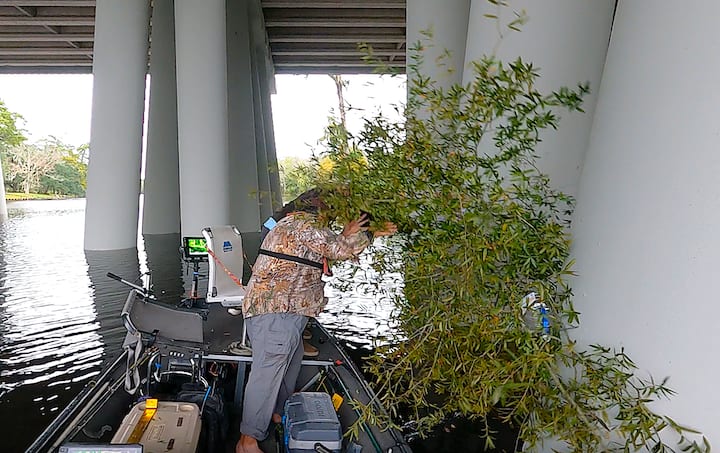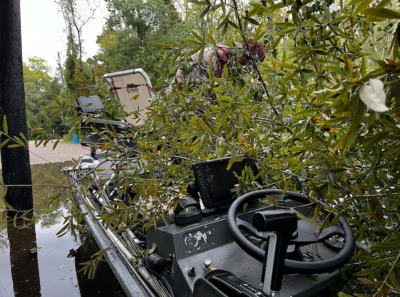Sinking Brush Piles for Crappie
Keith Lusher 11.06.23

It’s true that crappie fishermen often hold their cards close to the vest when it comes to divulging any information about their fishing spots. It’s also often the case that these anglers even develop personal relationships with certain spots that they have been fishing for many years. It can be a simple submerged log that always seems to hold fish or an entire tree-top canopy that stretches out 20 feet into the main river. Whichever the case, these spots have one thing in common; they all contain some kind of submerged structure.
I recently made a fishing trip with a gentleman who has been creating new fishing spots for quite some time. It was on this trip that I experienced his method of sinking brush piles

It all started when I received a text from Ray Miller one day. Miller is a true cajun and is a wealth of knowledge when it comes to hunting and fishing. Included in the text he sent me was a photo of a fallen tree branch in Millers’ yard. I didn’t know what I was looking at so I texted back asking what it was. “That’s my new fishing spot,” he said. Miller then went on to tell me how he was going to take the set of branches out to the river and sink them in order to create new fishing spots for the future. This piqued my interest so I asked if I could tag along to see how it was done.

I met Miller at the boat launch on the Tchefuncte River in Southeast La. Miller was backing down his flatboat which was covered in branches and leaves. Miller and I managed to squeeze into the boat and were able to barely peek over the top of the leaves as we idled south. We motored down the river until we reached the spot where Miller wanted to sink the brush piles. He eased up to a set of pilings that served as the feet to an interstate bridge. Miller picked up one of the branches and pointed out the dynamics of his rig. “I tie one cinderblock on the bottom of the branch and then I tie a two-liter soda bottle filled with air to the top,” Miller said. “That forces the leafy part of the branch to float up. It’s been my experience that fish hold to horizontal structure better than vertical structure that’s laying on the bottom,” he said. I grabbed the bottom of the branch and Miller grabbed the top and proceeded to throw it overboard. We repeated the process with two other branches. All three sunk in between the set of pilings. Miller said the current in the main river is strong so that it’s necessary to sink the brush piles in between the pilings so the concrete structure protects the brush from being pushed down river.

After sinking the brush piles Miller and I began fishing the river at various locations. Miller made several stops in the main river on this dreary, chilly day, and we were able to catch crappie almost everywhere we stopped. We both used a Panfish Assassin Tiny Shad in the Crystal Shad color to successfully put together a solid box of fish.
 But the highlight of the day came when we looped back to check on the sunken brush piles. Miller lowered his transducer down and aimed it at the brush pile. We looked at his Livescope screen and it lit up with fish. In only a few hours there were already crappie that were holding to the structure. “Sometimes just a couple of hours is all it takes to attract the baitfish. After that, the sac-a-lait follow,” he said. Needless to say, it was quite a productive morning on the river as I was able to take home a box of crappie for the cleaning table, but more importantly, I learned that instead of concentrating on finding other anglers’ spots, I could create my own by sinking brush piles.
But the highlight of the day came when we looped back to check on the sunken brush piles. Miller lowered his transducer down and aimed it at the brush pile. We looked at his Livescope screen and it lit up with fish. In only a few hours there were already crappie that were holding to the structure. “Sometimes just a couple of hours is all it takes to attract the baitfish. After that, the sac-a-lait follow,” he said. Needless to say, it was quite a productive morning on the river as I was able to take home a box of crappie for the cleaning table, but more importantly, I learned that instead of concentrating on finding other anglers’ spots, I could create my own by sinking brush piles.

